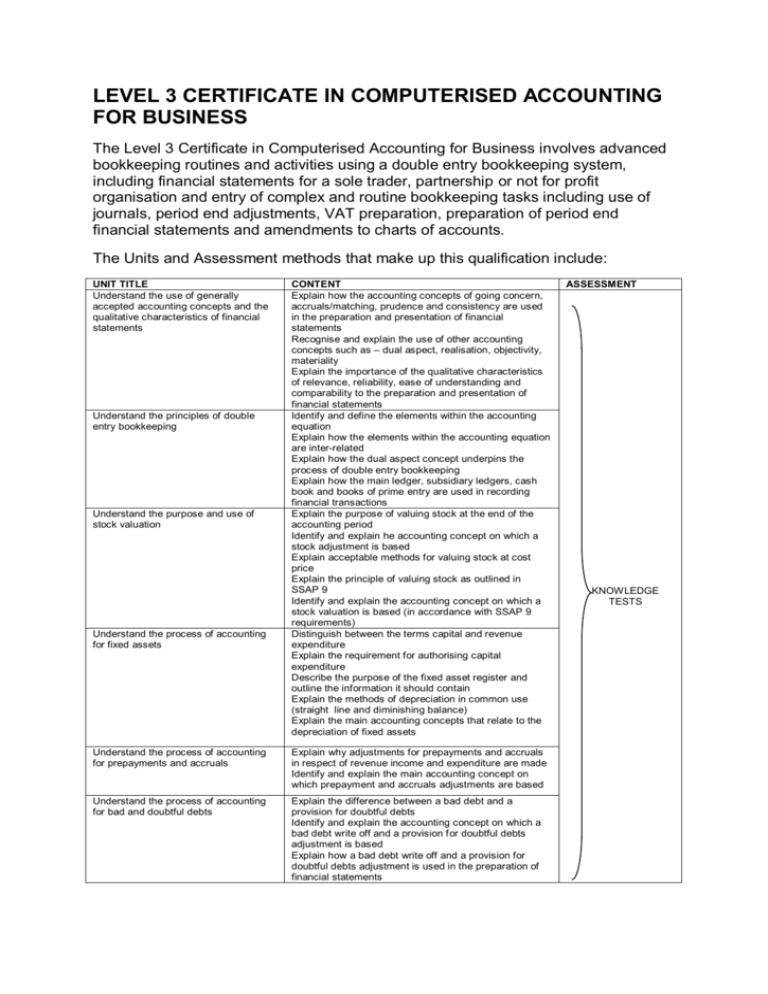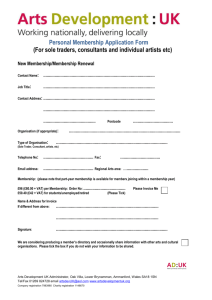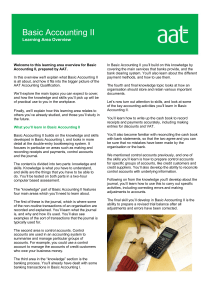level 3 certificate in computerised accounting for business
advertisement

LEVEL 3 CERTIFICATE IN COMPUTERISED ACCOUNTING FOR BUSINESS The Level 3 Certificate in Computerised Accounting for Business involves advanced bookkeeping routines and activities using a double entry bookkeeping system, including financial statements for a sole trader, partnership or not for profit organisation and entry of complex and routine bookkeeping tasks including use of journals, period end adjustments, VAT preparation, preparation of period end financial statements and amendments to charts of accounts. The Units and Assessment methods that make up this qualification include: UNIT TITLE Understand the use of generally accepted accounting concepts and the qualitative characteristics of financial statements Understand the principles of double entry bookkeeping Understand the purpose and use of stock valuation Understand the process of accounting for fixed assets CONTENT Explain how the accounting concepts of going concern, accruals/matching, prudence and consistency are used in the preparation and presentation of financial statements Recognise and explain the use of other accounting concepts such as – dual aspect, realisation, objectivity, materiality Explain the importance of the qualitative characteristics of relevance, reliability, ease of understanding and comparability to the preparation and presentation of financial statements Identify and define the elements within the accounting equation Explain how the elements within the accounting equation are inter-related Explain how the dual aspect concept underpins the process of double entry bookkeeping Explain how the main ledger, subsidiary ledgers, cash book and books of prime entry are used in recording financial transactions Explain the purpose of valuing stock at the end of the accounting period Identify and explain he accounting concept on which a stock adjustment is based Explain acceptable methods for valuing stock at cost price Explain the principle of valuing stock as outlined in SSAP 9 Identify and explain the accounting concept on which a stock valuation is based (in accordance with SSAP 9 requirements) Distinguish between the terms capital and revenue expenditure Explain the requirement for authorising capital expenditure Describe the purpose of the fixed asset register and outline the information it should contain Explain the methods of depreciation in common use (straight line and diminishing balance) Explain the main accounting concepts that relate to the depreciation of fixed assets Understand the process of accounting for prepayments and accruals Explain why adjustments for prepayments and accruals in respect of revenue income and expenditure are made Identify and explain the main accounting concept on which prepayment and accruals adjustments are based Understand the process of accounting for bad and doubtful debts Explain the difference between a bad debt and a provision for doubtful debts Identify and explain the accounting concept on which a bad debt write off and a provision for doubtful debts adjustment is based Explain how a bad debt write off and a provision for doubtful debts adjustment is used in the preparation of financial statements ASSESSMENT KNOWLEDGE TESTS Understand terminology relating to not for profit organisations Define the term ’not for profit’ and identify the forms in which such an organisation is likely to operate Identify and explain accounting terms used specifically in accounting for not for profit organisations Understand the purpose of a receipts and payments account Explain the use of a receipts and payments account in accounting for not for profit organisations Explain the limitations of a receipts and payments account Understand the function of financial statements prepared for a not for profit organisation Explain the function of the financial statements prepared on behalf of a not for profit organisation Understand single entry bookkeeping Describe circumstances in which a system of single entry bookkeeping is likely to be appropriate Describe how a single entry bookkeeping system operates Explain the limitations of a single entry bookkeeping system Explain the procedures for constructing ledger accounts from incomplete data Explain the need to apply accounting adjustments in the preparation of ledger accounts, constructed from incomplete records Define the term ‘partnership’ Assess the advantages and disadvantages of forming a partnership Understand the process of constructing ledger accounts from incomplete records Understand the partnership structure as a form of business entity Understand the legislation relating to partnerships Understand specific accounts used in partnership accounting Understand the procedures necessary to account for the changes in the structure of a partnership Understand the form and function of the trial balance Understand the purpose of the suspense account Understand the form and function of the financial statements Understand the form and function of the extended trial balance Understand VAT regulations Describe the main provisions of the Partnership Act 1890 Explain the relevance of a Partnership Agreement Outline the main provisions that a typical Partnership Agreement may contain Describe how the following are used in accounting for partnerships – partners’ fixed capital accounts, current accounts and drawings accounts, appropriation account and partnership balance sheet Describe situations that will result in a change to the structure of a partnership Explain the term ‘goodwill’ Explain how goodwill is accounted for following a change in the structure of a partnership Explain the purpose of the trial balance Discuss the limitations of the trial balance Describe the types of error not exposed by the trial balance Explain the procedures for tracing errors exposed by the trial balance Explain the purpose of a suspense account Describe the type of errors that will result in an imbalance in the books of account Describe the format and the purpose of the trading and profit and loss account Describe the format and the purpose of the balance sheet Describe the format and purpose of the extended trial balance Explain the procedures used in preparing the extended trial balance Identify sources of information on VAT Explain the relationship between the organisation and the relevant government agency Explain the VAT registration requirements Identify the information that must be included on business documentation of VAT registered businesses Recognise different types of inputs and outputs Identify how different types of supply are classified for VAT purposes Explain the requirements and the frequency of reporting for the following VAT schemes such as – annual accounting, cash accounting, flat rate scheme, standard scheme Recognise the implications and penalties for the organisation resulting from failure to abide by VAT regulations including late submission of Vat returns KNOWLEDGE TESTS Understand how the external environment impacts on how an organisation manages cash assets Be able to make informed decisions regarding the management of cash balances within an organisation Understand a range of accounting and other business techniques used to improve the efficiency of cash management procedures within an organisation Prepare forecasts of income and expenditure for a given accounting period Use forecasts to monitor cash flow within the organisation Use cash balances effectively Complete VAT returns accurately and in a timely manner Communicate VAT information Explain how the government monetary policies affect an organisation’s treasury functions Explain how recording and accounting practices may vary in different parts of the organisation Describe how an organisations’ principles of cash management will be determined by their specific financial regulations, guidelines and security procedures Identify statutory and other regulations relating to the management of cash balances in different types of organisations Identify characteristics of the main types of cash receipts and payments of – regular revenue receipts, capital receipts, exceptional receipts and payments and drawings Explain how an organisation can raise finance from a bank through overdrafts and loans and the basic terms and conditions associated with each of these types of financing Explain the different types of investment, risks and terms and conditions associated including certificate of deposit, government securities, local authority short term loans and shares Identify the component parts of cash budgets and how these are presented to aid decision making Explain the effects of lagged receipts and payments upon an organisation’s cash management Describe the relationship between cash flow accounting and accounting for income and expenditure Identify the principles of liquid management Explain the statistical techniques that can be used for estimating future trends such as – moving averages and allowance for inflation Identify the ways to manage risk and exposure when investing, to minimise potential losses to the organisation Determine the likely pattern of cash flows over the accounting period and anticipate any exceptional receipts or payments Ensure forecasts of future cash payments and receipts agree with known income and expenditure trends Prepare cash budgets and clearly indicate net cash requirements Monitor cash receipts and payments against budgeted cash flow Identify significant deviations from the cash budget and take corrective action with organisational policies Observe the organisation’s financial regulations and security procedures Take account of trends in the economic and financial environment in managing cash balances Manage cash, overdrafts and loans in order to maintain an adequate level of liquidity in line with cash forecasts Anticipate cash requirements and arrange overdraft and loan facilities on the most favourable terms available Invest surplus funds according to organisational policy and within defined financial authorisation limits Correctly identify and extract relevant data for a specific period from the accounting system Calculate accurately, relevant inputs and outputs Calculate accurately the VAT due to, or from, the relevant tax authority Make adjustments and declarations for any errors or omissions identified in previous VAT periods Complete accurately and submit a VAT return within the statutory time limits along with any associated payments Inform managers of the impact that the VAT payment may have on the company cash flow and financial forecasts Advise relevant people of the impact that any changes in VAT legislation, including the VAT rate, would have on the organisation’s recording systems Communicate in a courteous manner with the relevant tax authority when seeking guidance KNOWLEDGE TESTS Access, enter and edit accounting information Process business transactions from source documents Develop and interpret management information reports Set up a computerised accounting system ready for use Set up procedures for entry of accounting data accurately into records to meet requirements Explain how to code new entries Locate and display accounting data records to meet requirements Check data records meet needs, making corrections as necessary Explain the risks to data security and procedures used for data protection Manage data files effectively in line with local or legal guidelines and conventions for the storage and use of data where available Interpret and respond appropriately to a range of data and applications error messages Select and use appropriate tools and techniques to process transactions Use software tools to monitor accounts Respond appropriately to any transaction errors and problems Process period and year end routines Explain what information is required and how to present it Generate and interpret management reports as required Customise and format accounting documents and reports according to requirements Import and export data and link to other systems and software Install and update accounting software as required Configure accounting software for use Set up package parameters Set up initial account balances COMPUTERISED SIMULATION








